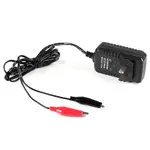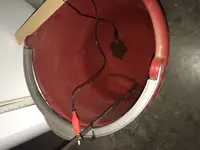View attachment 1788631
So this is what I ordered. Alligator clips already attached (score as I'm not into slicing wires lol). Do you attach the clip straight to the relic? Have you ever tried the "hanging wire" deal? I plan to use a small mop bucket (its pretty small). None of our finds have been super huge. Biggest I have right now is like 7-8 inches long, resembles some sort of blade (hyping myself up about what it is lol) but it fits in the bucket.
Yes I just did an article on this the other day. Your anode and cathode both go in the water. The one bubbling should be the one that’s the cleaning one, so if you get them in the water, and realize the wrong item is bubbling then reverse the clips. It’s a simple set up, I’m building another one today, as I’ve got a old knife, and lock I’m going to be using it on.
To note: positive(anode) battery cable connects to your source of material you want to use to help clean the item on the other end. You can use, copper, iron, steel, or graphite rods to use as a conductor. Make sure your electrode(anode)= + side of cable is connected to something that is clean, don’t put in a rusty steel washer, rusty flat washer, or anything that will affect the outcome of the voltage being passed through the item, you want a good clean connection. I’ve used stainless steel spoons, bent them over until a portion of it is underwater, but stainless steel produces(chromium) a particle you don’t want to touch, smell, or get anywhere on you. So I would suggest either using a washer such as a large lock washer, or other steel or iron item as long as it’s clean.
The negative (cathode) cable connects to the item you want to clean. You want both the anode, and cathode to be completely submerged otherwise one portion of the cathode(your item you’re cleaning) will not be clean if it’s not all the way submerged. Use caution when placing your hands in the water to check on your item, use latex, or if allergic like me I use Nitrile gloves which are cheaper then dirt at any hardware, auto parts store. You don’t want any of the residue from the electrolysis on your hands, sole will say I’m being over cautious here( but in 30 years of doing this method of cleaning) I’ve learned: 1. If you’ve got a cut on your hand, or open wound, the positively charged, and negatively charged ions in the water can get in your cut, and cause a mean infection. 2. If not cuts on your hand, and you reach in to grab your items the possibility of the water/electrolyte mixture that’s been cooking for a while is not something you want on your skin because it may contain any number of harmful substances. **so just buy some gloves, or if can’t afford any then use a pair of old dish cleaning gloves**.
While this process differs in length of time for cleaning, you want to make sure if you’re doing this inside that you have it in a well ventilated area(somewhere for the hydrogen gas/oxygen mixture from electrolysis to escape) because you don’t want to breathe that in for very long either. I’m not trying to make this sound harder than it is I’m just giving you pointers on how to do it effectively, safely, and to make sure you, your family, home, and object you’re cleaning aren’t in any way effected by electrolysis or any of its waste(water, crud at the bottom of the bucket).
Do like Smokey said, use that powder, salt, lemon juice(smells better) or any form of electrolyte you want to. You SHOULD test out an item first before jumping on to the item you want to clean, with this probably being your first time, you want to make sure you don’t overcook it(toast it), if you’re going to be cleaning anything of value(gold,silver, aluminum, or even plated items) USE EXTREME CAUTION.. the fine details on coins will wear off if not monitored closely, gold, and silver items will lose small minute portions of them by using electrolysis, so don’t use it too long, and plated items( spoons, rings, anything that is not “genuine” precious metals will flake, crust, or will leave you with just a copper, or brass spoon, and have eaten away the gold or silver plating( ONLY if not watched properly.
So in the end, negative side goes to your item you want cleaned, positive to anything metallic(iron, steel, graphite, or any piece of scrap you’ve got lying around, just make sure that it is clean so you get a good clean connection. Secondly use caution(gloves, glasses, properly ventilated area), I may sound overly cautious, but I’ve been doing this a long time, and have seen others effected by using it, that didn’t heed warnings of others by not breathing in fumes, or reaching into a bucket full of harsh waste, gases, and toxic water.
I made it sound hard but + to cleaning agent, - to material you want to clean.





